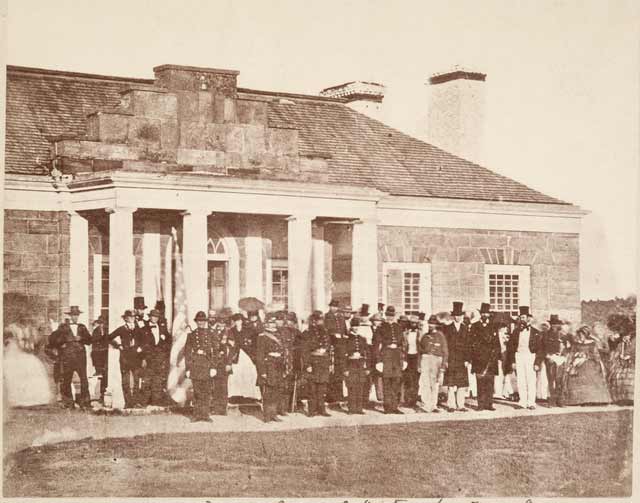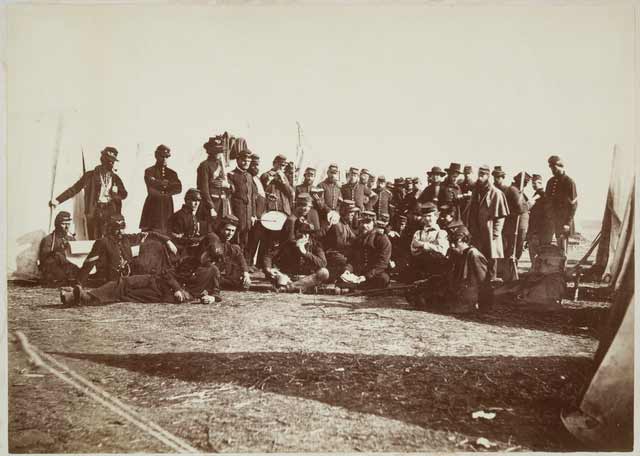The Civil War (1861-1865)
When the Civil War began on April 12, 1861, Minnesota's governor, Alexander Ramsey, was in Washington, D.C. Ramsey immediately promised President Lincoln a regiment of 1,000 volunteer soldiers from Minnesota. These were the first troops offered to fight for the United States during the Civil War. In order to organize and train these raw recruits, the state of Minnesota reopened Fort Snelling to serve as a rendezvous and training center for the volunteer soldiers.
While at the fort, recruits learned the basics of soldiering and spent the majority of their time marching, drilling with their weapons, and standing guard duty. After the draft was instituted in 1863, several large wooden barracks were constructed outside the fort's stone walls to accommodate the large numbers of new soldiers. Fort Snelling also served as a mustering-out location for Minnesota units completing their term of service. From 1861–1865 nearly 25,000 soldiers passed through Fort Snelling.
Minnesota's soldiers played pivotal roles in many battles across the south. Among the state's most famous units was the First Minnesota Volunteer Infantry Regiment, which was not only the first regiment of soldiers offered to fight for the Union army, but also halted a determined Confederate assault at Gettysburg in July 1863, helping to save the Union line. Other units, like the Second Minnesota Volunteer Infantry Regiment, fought in the war's western theater and distinguished themselves in battles at Shiloh, Vicksburg, Chickamauga, and Atlanta as well as on General William T. Sherman's "March to the Sea." Others, such as the Third Minnesota Volunteer Infantry Regiment, returned to Minnesota and fought in the U.S.-Dakota War of 1862.
In total, Minnesota furnished 11 infantry regiments, two companies of sharpshooters, several units of artillery and cavalry, and several dozen sailors. During the war 104 African American men from Minnesota volunteered for service in the army's segregated African American units, including the First Iowa African Infantry Regiment, as well as the Eighteenth and Sixty-eighth Regiments of United States Colored Troops (USCT). More than 2,500 Minnesotans died in battle or from illness, and many more were wounded during the Civil War.
Resources
- Bishop, Judson. The Story of a Regiment: Being a Narrative of the Service of the Second Regiment Minnesota Veteran Volunteer Infantry in the Civil War of 1861 to 1865. St. Cloud, MN: North Star Press, 2000.
- Carley, Kenneth. Minnesota in the Civil War: An Illustrated History. St. Paul, MN: Minnesota Historical Society Press, 2006.
- Cassady, Matthew and Peter J. DeCarlo. "Fort Snelling in the Civil and US–Dakota Wars, 1861–1866." MNopedia, November 23, 2015.
- Moe, Richard. Last Full Measure: The Life and Death of the First Minnesota Volunteers. St. Paul, MN: Minnesota Historical Society Press, 2001.
- Newson, Mary Jeannette. "Memories of Fort Snelling in Civil War Days." (PDF) Minnesota History 15, no. 4 (1934): 395–404.
- Osman, Stephen E. Fort Snelling and the Civil War. St. Paul, MN: Ramsey County Historical Society, 2017.
- Osman, Stephen E. "General Sibley's Contraband Teamsters." Minnesota's Heritage no. 7 (January 2013): 54–74.
- Smith, Hampton. "First Minnesota Volunteer Infantry Regiment." MNopedia, March 13, 2012.
- Wright, Charles A. No More Gallant a Deed: A Civil War Memoir of the First Minnesota Volunteers. St. Paul, MN: Minnesota Historical Society Press, 2001.

Officers of the 1st Minnesota Volunteers standing in front of the commandant's quarters, May 1861. Source: MNHS Collections.

Company E, Eighth Minnesota Volunteer Infantry, Fort Snelling, 1862. Source: MNHS collections.

Fort Snelling's Extent, 1861-1865. Drawn by David Geister, 2004. Source: MNHS Collections.
